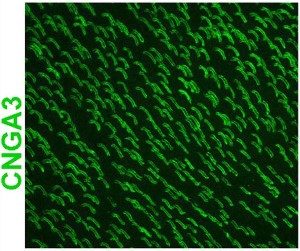Overview
- Peptide (C)GHGFSPDRENSEDASKAD, corresponding to amino acid residues 594-611 of rat CNGA3 (accession number Q9QWN7). Intracellular, C-terminus.

 Western blot analysis of rat brain membranes:1. Anti-CNGA3 Antibody (#APC-060), (1:200).
Western blot analysis of rat brain membranes:1. Anti-CNGA3 Antibody (#APC-060), (1:200).
2. Anti-CNGA3 Antibody, preincubated with CNGA3 Blocking Peptide (#BLP-PC060).
 Expression of CNG3 in rat brainImmunohistochemical staining of frozen rat hippocampal dentate gyrus (DG) sections using Anti-CNGA3 Antibody (#APC-060). Neurons were found in the hilus of the DG with dendritic processes extending across the granule cell layer (arrows) both in the dorsal blade (A) and ventral blade (B). Diaminobenzidine color product is blue-black (arrows). DAPI is used as the counterstain (silver).
Expression of CNG3 in rat brainImmunohistochemical staining of frozen rat hippocampal dentate gyrus (DG) sections using Anti-CNGA3 Antibody (#APC-060). Neurons were found in the hilus of the DG with dendritic processes extending across the granule cell layer (arrows) both in the dorsal blade (A) and ventral blade (B). Diaminobenzidine color product is blue-black (arrows). DAPI is used as the counterstain (silver).
- Biel, M. et al.(1999) Rev. Physiol. Biochem. Pharmacol. 135, 151.
- Kramer, R. H. and Molokanova, E. (2001) J. Exp. Biol. 204, 2921.
- Matulef, K. and Zagotta, W.N. (2003) Annu. Rev. Cell. Dev. Biol. 19, 23.
- www.iuphar-db.org
- Molday, R.S. (1996) Curr. Opin. Neurobiol. 6, 445.
- Biel, M. et al. (1999) Proc. Natl. Acad. Sci. U.S.A. 96, 7553.
Cyclic nucleotides are important second messengers in many cellular functions such as visual transduction, and relaxation of smooth muscle cells. Cyclic nucleotides exert their cellular functions through three major classes of cellular receptors, one of them is the cyclic nucleotide-gated (CNG) channels.1 The CNG channels are non-selective cation channels facilitating the influx of Na+ and Ca2+ ions, following activation by intracellular cyclic nucleotides.2 In vertebrates, six members of the CNG channel family were identified and grouped according to sequence homology into two subtypes, CNGA and CNGB. The native CNG channels are composed of a and b subunits in a tetrameric configuration. To date, four types of the a subunits (CNGA1-4) and two b subunits (CNGB1, CNGB3) have been characterized.3-4
Each subunit contains 6 TM domains and intracellular cAMP or cGMP binding domains but, are also modulated by other factors including phosphorylation and calmodulin.5 In a heterologous expression system, only the a subunits are capable of forming functional homomeric channels.
CNG ion channels are essential in visual and olfactory signal transduction. The CNGA3 channel is primarily expressed in cone photoreceptors where it participates in light transduction (daylight and color vision). CNG channels expression was also found in the hippocampus, cortex, Purkinje cells and other neural derived tissues. CNGA3 was also detected in kidney, heart, brain and sperm, where it was thought to have an important role in the control of sperm motility and fertility. However, CNGA3-deficient mice were shown to be as fertile and produce at normal rate as wild types.6
Application key:
Species reactivity key:
Anti-CNGA3 Antibody (#APC-060) is a highly specific antibody directed against an epitope of the rat protein. The antibody can be used in western blot and immunohistochemistry applications. It has been designed to recognize CNGA3 from rat and mouse samples.

Expression of CNGA3 in mouse neuroretina.Immunohistochemical staining of mouse neuroretina using Anti-CNGA3 Antibody (#APC-060). CNGA3 staining (green) is specifically detected in cone cells.Adapted from Sakurai, K. et al. (2016) Sci. Rep. 6, 32521. with permission of SPRINGER NATURE.
Applications
Citations
- Mouse neuroretina (1:80).
Sakurai, K. et al. (2016) Sci. Rep. 6, 32521. - Rat inner ear sections.
Selvakumar, D. et al. (2012) Biochem. J. 443, 463. - Rat retina sections.
Gutierrez-Mecinas, M. et al. (2008) Neuroscience 153, 1164.
- Bumbalo, R. et al. (2017) Cell. Mol. Neurobiol. 37, 729.
- Varea, E. et al. (2011) Front. Neurosci. 5, 1.
- Gutierrez-Mecinas, M. et al. (2007) Eur. J. Neurosci. 26, 392.
- Kruse, L.S. et al. (2006) Neurosci. Lett. 404, 202.
